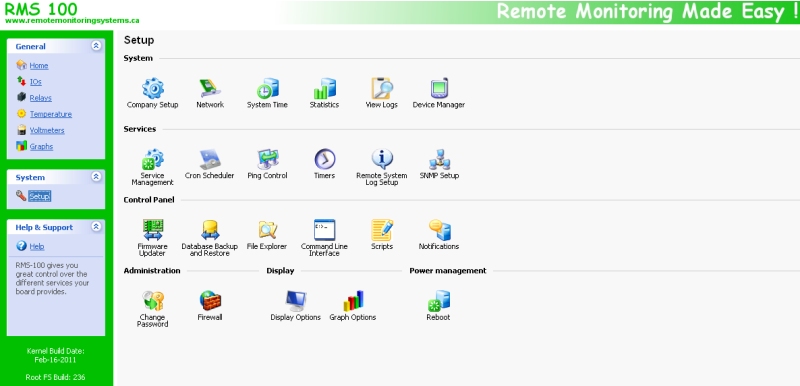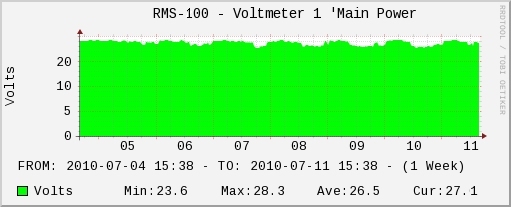Setting up RMS-100
Connect
8 - 60 volts dc power (minimum 500 ma) to the green terminal block
that is beside the on/off switch (See figure 1). Connect an Ethernet cable
to the rj-45 jack on the RMS-100 board. Turn the device on with the
on/off switch. It takes the RMS-100 board approximately 30 seconds
to bring up the Linux operating system. The RMS-100 will signal it is ready
by first blinking the green status light in a continuous heartbeat sequence. After a few seconds the
red alarm leds will display a light sequence. The board is now fully booted up and is ready for
configuration.
Note1: RMS-100 units should be mounted inside a steel enclosure that is grounded
properly to prevent Electro Magnetic Interference.

Figure 1
RMS-100
is powered up, Now what?
We recommend configuring RMS-100 before deploying it in the field.
Simply plug RMS-100 into your network or computer using an Ethernet cable (Straight or Cross).
When RMS-100
is turned on it boots the Linux operating system and uses the values stored
in its configuration files to bring up the system. The default values consist of an IP address, username, and password.
The default IP address is 10.10.10.10. The default username is root. The default password is pass.

Give your computer an ip address in the 10.10.10.X class. For instance use 10.10.10.1.
Set your computers Netmask to 255.255.255.0 There is no need to set a Gateway at this time.
Open your favorite web browser and enter 10.10.10.10 into the address bar, press enter or the
go button. You should be presented with a password box like the one below.

Enter in the default username and password then press the OK button. You will be taken to the
RMS-100 Home page. This page contains an overview of all of the functionality of the RMS-100 board.

In the left side panel, click on the Setup icon. This takes you to the System Setup area
shown below.

Here you will want to visit the following areas: Company Setup , Network , System Time , Contact Information , and Change Password. Adjust the Station Name, Location, Domain Name, IP Address, Subnet Mask, Gateway, DNS, and password you want the device to have. Caution must be taken when configuring the device, entering incorrect values may cause you to lose connectivity with the device, forcing the need for a factory reset. Once you have RMS-100 configured properly, it is ready to deploy in the field. Below are some basic examples of how to install the RMS-100 unit.
Installation
Basic Installation Example 1
Monitoring your Battery Bank Voltage
To monitor
your main battery power supply, run a wire from the positive side of the
battery bank to one of the Voltmeter positive inputs. Run a second wire
from the negative side of the battery bank to the corresponding Voltmeter negative
input as shown in Figure 2. Connect RMS-100 to the internet with
a common Ethernet cable and monitor the voltage level of your battery bank
with a web browser.

Figure 2
Basic Installation Example 2
Signal Strength on SAF Microwave Radios
Radios that have an external RSSI port for checking signal strength can
be monitored with ease. Simply attach the RSSI output from the radio to one of the
Voltmeter inputs on the RMS-100 board (see Figure 3).
Monitor the signal strength of your radios with a web browser and/or have RMS-100
alert you by email if the signal falls below a certain threshold.

Figure 3
Basic Installation Example 3
Turning Devices ON/OFF
To make any device remotely resetable, simply cut one of the wires in the power cord of a device. Attach one side of the cut wire to the COM terminal on one of the Power Relays. Attach the other side of the cut wire to the NC (normally closed) terminal on the corresponding Power Relay. Reset your device at any time using RMS-100. Note: in the Normally Closed configuration, power still flows to your device even when the RMS-100 device is turned off. Virtually any 1 to 240 volt AC or DC device can be turned ON/OFF remotely this way. The two Power Relays can pass up to 5 amps each. For devices that should be by default turned off, use the COM and NO (normally open) configuration. Figure 4 illustrates just one of the many ways you can set up devices for remote reset.

Figure 4
Basic Installation Example 4
Using the Alarm pins to monitor door contacts
To give your equipment room some security you can
use widely available common door contacts. These contacts allow current to flow
through them when they are in close proximity with each other. RMS-100 can
sense when the contacts are together or apart. Program the alarm pins to send an
email, run a custom file, and/or toggle a relay when the door gets opened. The diagram below (figure
5) shows how to use Alarm pin 5 to monitor door contacts.
See our Projects Page for
instructions on how to use the alarm pins to prevent solar panel theft.
Note1: the LED5 light is on when the contacts are together. This is the armed position.
Note2: each Alarm pin has a corresponding LED.

Figure 5
RMS-100 Hardware Screen Shot

Built in Graph Examples
Main Battery Power on Apex Mountain

The graph above depicts main battery power at our wireless internet repeater site on Apex Mountain. Bumps in the graph represent charging from either solar panels or an Air403 wind turbine. Supplementary power is provided by a Honda Generator that is remote started with RMS-100. The 24v battery bank is monitored by RMS-100 and the graph is updated every minute. This provides a quick and easy way to check battery levels at anytime from anywhere a web browser is available!
Temperature Monitor on Roderick Dhu Mountain

The graph above depicts room temperature at our wireless internet repeater site on Roderick Dhu Mountain. Dips or bumps in the graph represent temperature changes. The temperature of our equipment room is monitored by RMS-100 and polled every minute. This provides a quick and easy way to check temperature at anytime from anywhere a web browser is available!
System Work Load Monitor on Roderick Dhu Mountain

The graph above depicts system load of the RMS-100 at our wireless internet repeater site on Roderick Dhu Mountain. Dips or bumps in the graph shows how hard the processor is working. This provides a quick and easy way to check system performance at anytime from anywhere a web browser is available!
RMS-100 is a remote site monitoring board with many features to keep your equipment running reliably.
Our Story
EtherTek Circuits started its business in 2001. Ever since we have provided remote monitoring and control solutions for Remote Tower Sites, the Oil & Gas industry, Telemetry systems for Agriculture, Municipalities, Mines, Solar Farms, Hydro Plants, and the Military.


